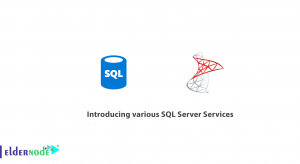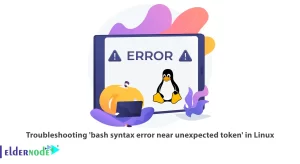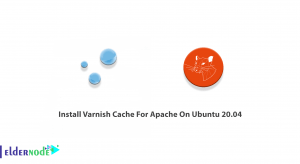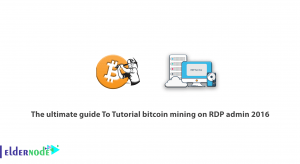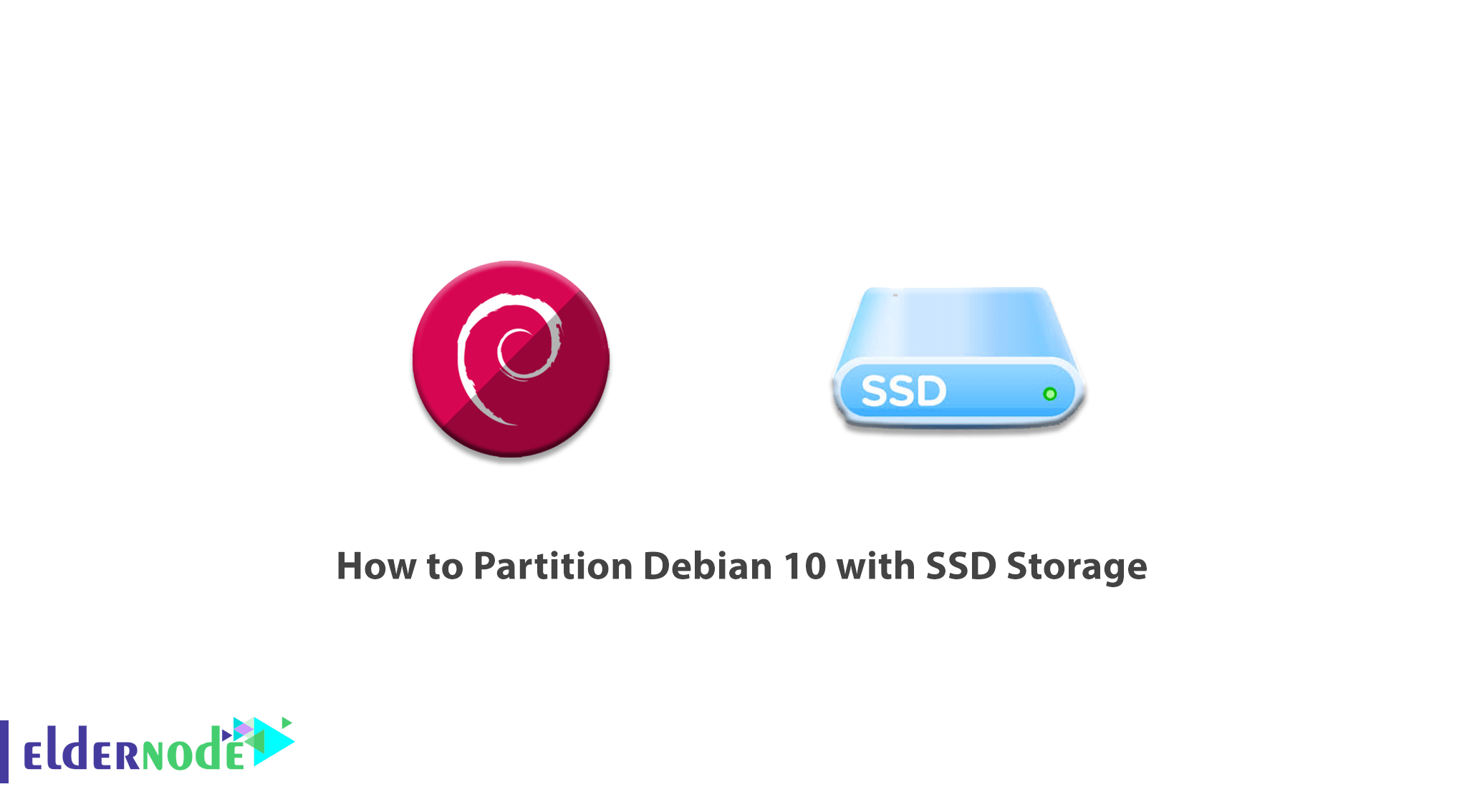
The solid-state drive uses flash memory to deliver vastly superior performance and durability. SSDs are faster and more durable than HHDs and do not have any moving parts like them. Supporting reading and writing data, its capacity is much larger and people prefer to use it. Internal SSDs connect to a computer like a hard disk. In this article, you will learn How to Partition Debian 10 with SSD Storage. People believe that time is not buyable, but you can do this with SSD. So, visit Eldernode to purchase SSD VPS and enjoy the speed of progress and innovation.
Table of Contents
Tutorial Partition Debian 10 with SSD Storage
Disk partitioning (Partition Debian 10 With SSD)
If you wish to install a server properly, you need to partitioning. When you create one or more storage regions and manage each one separately, it is called disk partitioning. You may do this before creating any file system and while you are preparing a newly installed disk. The information of partitions’ locations and sizes in an area known as partition table is stored in the disk. The information will be read by the Operating System before any other part of the disk. Debian developers have considered several varieties of partitioning programs to work on various types of hard disk and computer architectures such as partman, fdisk, and cfdisk.
Recommended partitioning scheme
If you have multi-user systems or systems with lots of disk space, you are recommended to put /var,/tmp, and /home each on their own partitions separate from the / partition. You will need a separate /user/local partition if you wish to install many programs that are not part of Debian distributions. Make /var/mail as a separate partition if your machine will be a mail server. If you are setting up a server with lots of user accounts, having a separate and large /home partition is suggested.
Partitioning Debian 10 with SSD
When you start to install your Debian Server and pass the required steps, you will reach the step of partitioning. It is not at all an optional step and is indispensable in the installation process. also, you will choose the filesystem to be used. It helps you to control data security and the administration of the server.
Partitioning tool
If you are a new user, traditional partitioning would be difficult for you since you must define the various partitions of the disk on which the Linux filesystem and virtual memory (swap) will be stored. Also, if you have another Operating System and you wish to keep it. In this way, you need to make sure that you do not alter its partitions and resize them until they would not damage your machine.
Note: You can use the mode of ”guided” that partition software will provide. The suggestions of this software are close to what you wish to do. Here you must choose your partition mode.
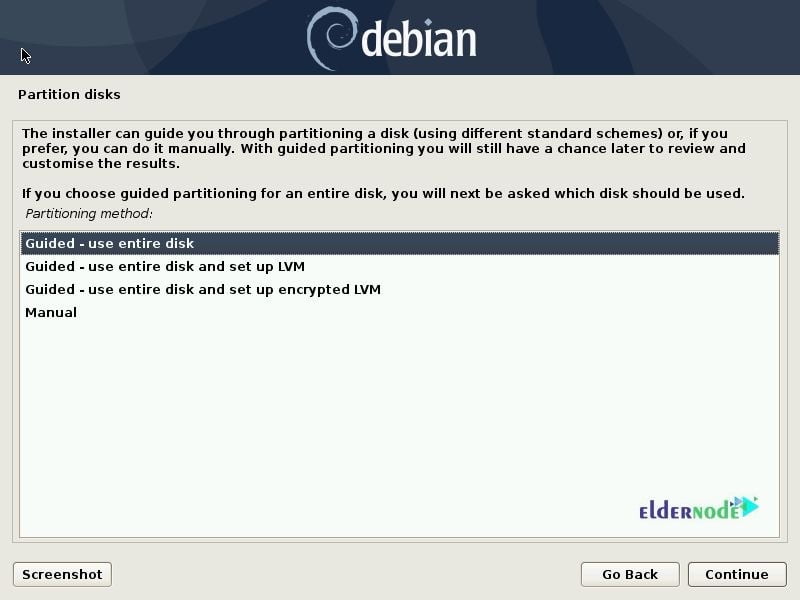
If you are using Linux solely, you are recommended to choose the option ”Guided – use entire disk” to start guided partitioning. But if Linux works alongside other already existing partitions, manual partitioning should be chosen. The guided partition can also set up LVM logical volumes instead of partitions.
Guided partitioning (Partition Debian With SSD)
Three partitioning methods are provided by the guided partitioning including ”All files in one partition”, ”Separated /home partition”, and ”Separate /home, var, and /tmp partitions”.
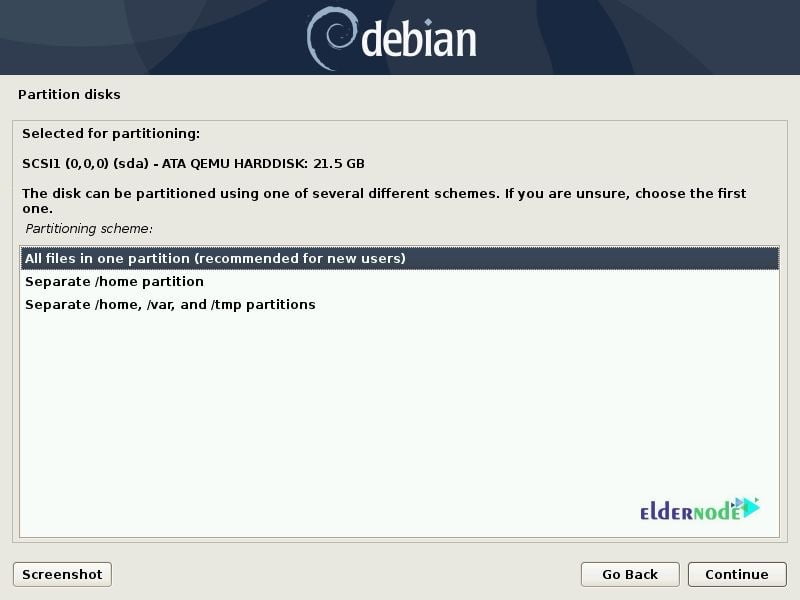
All files in one partition
This simple and robust partitioning is perfect for personal or single-user systems. Using this method will create two partitions: the first will house the complete system, and the second the virtual memory (swap).
Separated /home partition
This method splits the file in two: one partition contains the Linux system (/), and the second contains ”home directories”
Separate /home, var, and /tmp partitions
The third method is better to be chosen for the servers and multi-user systems. It decides the file tree into many partitions. The divisions have several advantages since users will not be able to lock up the server by consuming all available hard drive space and can not clog up the rest of the system.
Validating partitioning
When you choose the type of partition, the software will calculate a suggestion and describe it on the screen. You will also be able to modify it if you wish and choose another filesystem if the standard choice is not appropriate. However, you will face a reasonable partitioning which helps you to accept it and select the ”Finish partitioning and write changes to disk” entry.

Manual partitioning
In the section of choosing the partition mode, you saw the option of ”manual” which is possible to be chosen like others. When you decide to partition manually, you will have some advantages such as smooth backup, restore process, ability to maintain especially allocated partitions for the different section for storages, and so on. If you select manual partitioning, it would go on more flexible and it is up to you to size the partitions.
The available disks, their partitions, and any possible free space (that has not yet been partitioned) are displayed on the first screen. So, you can select each one of them or erase all partitions on a disk by selecting it.
To create a new partition manually, select free space on a disk. The guided partition also can do this for you.
But what you must do when choosing a partition?
Try to indicate the manner in which you will use it. The list below helps you how to consider them. However, you can choose to not use it and leave it unchanged.
1- Format it and include it in the file tree by choosing a mount point.
2- Use it as a swap partition.
3- make it into a ”physical volume for encryption”.
4- Use it as a RAID device.
Finally, you can review the partitions. At the bottom of the list, choose ”Finish partitioning and write changes to disk”.
Conclusion
In this article, you learned How To Partition Debian 10 With SSD Storage. You will speed up your system by about 200% when you start using an SSD. In case you are interested in learning more, find our related article on What is SSD Hard and how does it work.
